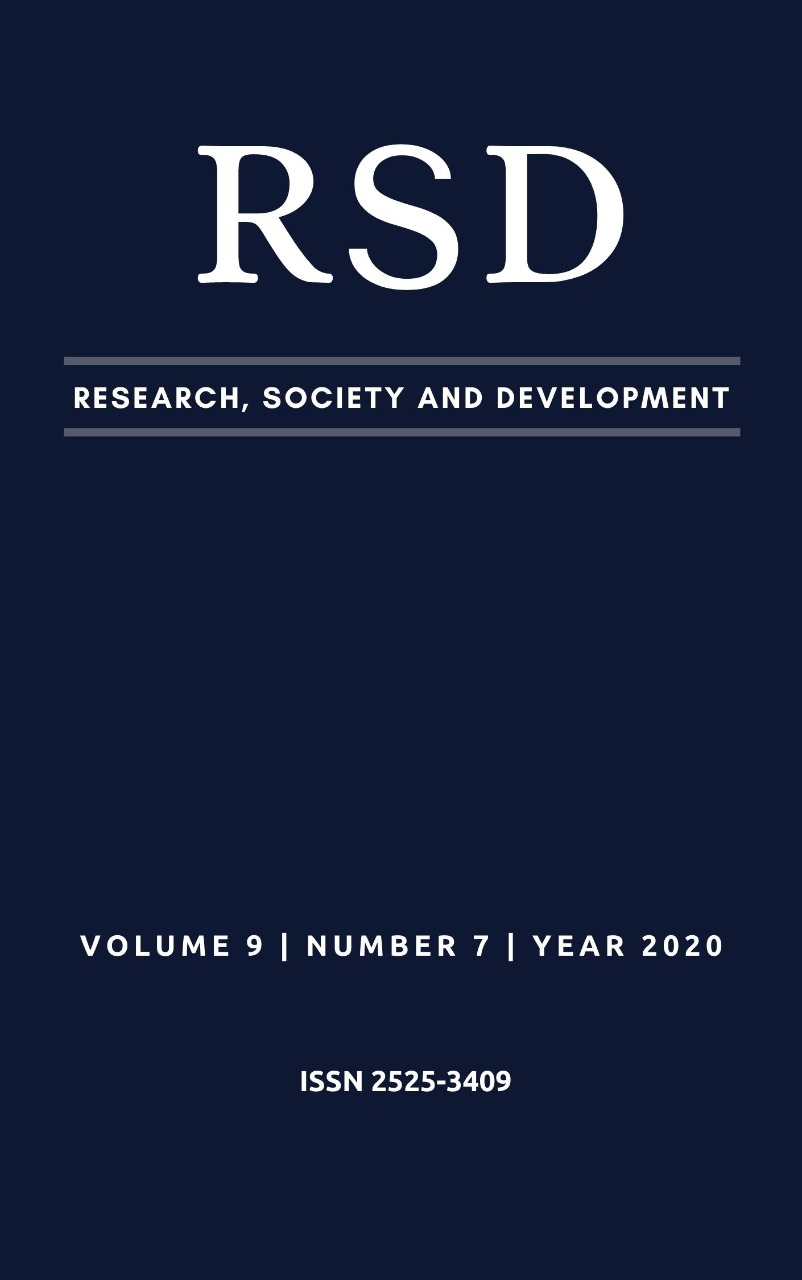Violencia doméstica como tema transversal en la formación profesional del área de salud
DOI:
https://doi.org/10.33448/rsd-v9i7.3917Palabras clave:
Violencia doméstica, Formación profesional, estudiantes, Práctica profesional, Atención a la salud.Resumen
Objetivo: averiguar la violencia doméstica como tema transversal en la formación profesional de los cursos de graduación del área de salud. Método: estudio de abordaje cualitativo del tipo descriptivo-exploratorio, realizado con 32 estudiantes del curso de graduación en enfermería, odontología, fisioterapia y medicina. Se utilizó de la entrevista semiestructurada para recolección de datos y para análisis de los datos la técnica de análisis contenido. Resultados: la violencia doméstica está siendo abordada en los cursos de graduación del área de salud restringida a algunas disciplinas, no atendiendo la complejidad de la problemática y enfrentamiento de los futuros profesionales a las personas en situación de violencia doméstica. Conclusión: la violencia doméstica necesita ser discutida durante la formación profesional de forma transversal, siendo necesario incluir la temática en los currículos para articulación teórico-práctica, comprendiendo la construcción del aprendizaje y desarrollo de competencias y habilidades que puedan subsidiar la práctica profesional.
Referencias
Amarijo, C. L., et al. (2018). Assimilação teórica e prática da violência doméstica: profissionais de enfermagem atendendo vítimas na atenção primária. Rev. enferm. UERJ; 26: e33874, jan.-dez. doi: 10.12957/reuerj.2018.33874.
Atherton, H. (2013). Use of email for consulting with patients in general practice. Br J Gen Pract., 63,(608), 11811-19. doi: 10.3399/bjgp13X664072.
Bardin, L. (2011). Análise de Conteúdo. São Paulo: Edições 70.
Brasil (2001). Ministério de Educação. Conselho Nacional de Educação. Diretrizes Curriculares Nacionais dos cursos de Graduação em Enfermagem, Medicina e Nutrição. Diário Oficial da União, Brasília, Seção 1E, p.13.
Brasil (2002). Ministério da Saúde. Secretaria de Políticas de Saúde. Violência intrafamiliar: orientações para a prática em serviço. Brasília: Ministério da Saúde.
Brasil (2004). Ministério da Saúde. Gabinete do Ministério. Portaria nº 936, de 18 de maio de 2004. Dispõe sobre a estruturação da Rede Nacional de Prevenção da Violência e Promoção da Saúde e a Implantação e Implementação de Núcleos de Prevenção à Violência em Estados e Municípios. Diário Oficial da União, Brasília, Seção 1, p.52.
Brasil (2015). Presidência da República. Secretaria de Comunicação Social. Pesquisa brasileira de mídia 2015: hábitos de consumo de mídia pela população brasileira. Brasília: Secretaria de Comunicação Social.
Rocha, B. D., et al. (2015). Violence against women: perceptions of nursing students' about the focus on the formation. Investeduc Enferm, 33, (4). doi: 10.17533/udea.iee.v33n2a08.
Dement, A. (2016). Attitudes of University Students Towards Domestic Violence Against Women. Clin Invest Med., 39, (6). doi: 10.25011/cim.v39i6.27523.
Distrito Federal (2009). Secretaria de Estado de Saúde do Distrito Federal (SES-DF). Manual para Atendimento às Vítimas de Violência na Rede de Saúde Pública do Distrito Federal. Brasília: Secretaria de Saúde do Distrito Federal.
Kong, H-H., et al. (2018). Medical students’ clinical performance of dealing with patients in the context of domestic violence. Korean J Med Educ., 30, (1), 31-40. doi: 10.3946/kjme.2018.79.
Lobato, G. R., et al. (2012). Desafios da atenção à violência doméstica contra crianças e adolescentes no Programa Saúde da Família em cidade de médio porte do Estado do Rio de Janeiro, Brasil. Cad. Saúde Pública, 28, (9), 1749-58. doi: 10.1590/S0102-311X2012000900013.
Machado, J. C. & Vilela, A.B.A. (2018). Conhecimento de estudantes de enfermagem na identificação de crianças em situação de violência doméstica. Rev Enferm UFPE online, 12, (1), 83-90. doi: 10.5205/1981-8963-v12i01a23285p83-90-2018
Machado, J. C., et al. (2018). Violência doméstica contra a criança sob a ótica de estudantes de graduação em enfermagem. Rev Enferm UFSM, v.8, n.1, p.157-71. doi: /10.5902/2179769228099.
Norman, A. H. & Tesser, C.D.(2015). Acesso ao cuidado na Estratégia Saúde da Família: equilíbrio entre demanda espontânea e prevenção/promoção da saúde. Saude Soc. 24, (1), 165-179. doi: 10.1590/S0104-12902015000100013
Pereira, F. G. F., et al.(2015). Práticas educativas em saúde na formação de acadêmicos de enfermagem. Cogitare Enferm. 20, (2), 332-7. Doi: 10.5380/ce.v20i2.39767.
Pereira, A.S. et al. (2018). Metodologia da pesquisa científica. [e-book]. Santa Maria. Ed. UAB/NTE/UFSM. Acesso em: 30 Abril 2020. Disponível em: https://repositorio.ufsm.br/bitstream/handle/1/15824/Lic_Computacao_Metodologia-Pesquisa-Cientifica.pdf?sequence=1.
Pessoni, A. & Akerman, M. (2015). Percepções de docentes e discentes sobre o uso educativo de mídias sociais. ABCS Health Sci., 40, (3), 178-83. doi: 10.7322/abcshs.v40i3.792.
Santos, W. J., et al. (2018). Violência Doméstica Contra a Mulher Perpetrada por Parceiro Íntimo: Representações Sociais de Profissionais da Atenção Primária à Saúde. Rev Fund Care Online. 10, (3), 770-777. doi: 10.9789/2175-5361.2018.v10i3.770-777
Seraphim, A. P. C., et al. (2014). O distanciamento entre a formação e a prática profissional. Revista Odontológica de Araçatuba, 35, (1), 14-17.
Soares, J. S. F. & Lopes, M. J. M. (2018). Experiências de mulheres em situação de violência em busca de atenção no setor saúde e na rede intersetorial. Rev. Interface (Botucatu), 22, (66). doi: 10.1590/1807-57622016.0835
Villela, W. V., et al. (2011). Ambiguidades e contradições no atendimento de mulheres que sofrem violência. Rev. Saude Soc., v.20, n.1, p.113-23. doi: 10.1590/S0104-12902011000100014
World Health Organization (2014). Global status report on violence prevention 2014. Genebra: World Health Organization.
World Health Organization (2013). Responding to Intimate Partner Violence and Sexual Violence Against Women. Clinical and Policy Guideline. Geneva (CH): WHO.
Descargas
Publicado
Número
Sección
Licencia
Los autores que publican en esta revista concuerdan con los siguientes términos:
1) Los autores mantienen los derechos de autor y conceden a la revista el derecho de primera publicación, con el trabajo simultáneamente licenciado bajo la Licencia Creative Commons Attribution que permite el compartir el trabajo con reconocimiento de la autoría y publicación inicial en esta revista.
2) Los autores tienen autorización para asumir contratos adicionales por separado, para distribución no exclusiva de la versión del trabajo publicada en esta revista (por ejemplo, publicar en repositorio institucional o como capítulo de libro), con reconocimiento de autoría y publicación inicial en esta revista.
3) Los autores tienen permiso y son estimulados a publicar y distribuir su trabajo en línea (por ejemplo, en repositorios institucionales o en su página personal) a cualquier punto antes o durante el proceso editorial, ya que esto puede generar cambios productivos, así como aumentar el impacto y la cita del trabajo publicado.


